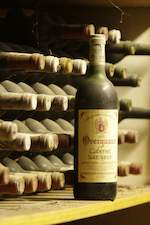Being a traditionalist does not preclude innovation. Braam van Velden was born into a family of progressive farmers of this land since 1784: his grandfather bought a portion of the original By-den-Weg farm from his maternal grandfather in 1905. He named it Overgaauw: the maiden name of the wife of the first Van Velden from Holland to settle in the Cape Dutch colony.

The cellar Braam's grandfather built in 1909, and where his father Oom David continued making wine for sale to producing wholesalers when he took over the farm in 1945, remains the core of the existing winery. During Braarn's tenure it was simply extended into a double-storey building, partly underground for barrel and bottle storage under optimally cool, constant conditions.
It's also the ideal place for the Overgaauw vinothèque. Another Van Velden tradition and integral to their sense of history, the collection is also a way of tracking their wines' development over the years. Vertical tastings of anything from two to four decades of vintages are an Overgaauw speciality sometimes organised for wine lovers.
'We [Oom David, Braam and David] tasted a bottle of Overgaauw Cabernet Sauvignon from our maiden 1970 vintage together during our centenary year in 2005: 100 years of Van Veldens on the farm.'
Oom David introduced several new varieties to the farm's 40 hectares of vineyards (also supporting fruit and tobacco into Braam's tenure; the tasting room was once a tobacco store). Many of the new grape types were untried in the Cape and were to find their finest expression in wines made by Braam.
There were the plantings in 1949 of Portuguese varieties traditionally used to make fine ports: tinta barocca, tinta francisca, cornifesto, souzao, malvasia rei and, later, tinta roriz. Originally destined for ports made by the Cape's big producing wholesalers, Van Velden second and third generation put them together for the novel Overgaauw Dry Red in the 1970s, labelled Overtinto in the 1980s. [The use of port varieties for red wine is currently being re-introduced by the Cape Port Producers Association.]
Braam was one of the first to bring top port variety touriga nacional to the Cape's vineyards in the 1980s. The farm was initially the only vineyard of this variety while the new vines underwent their quarantine period. It became the Overgaauw Cape Vintage, first made in 1992 in the authentic, drier Portuguese style and introduced at the Guild auction in 1995. [Braam is one of the eight veteran Cape winemakers to have founded the Guild in 1982.]
So it was with the Overgaauw Sylvaner. It's the only white wine made from this popular German/ Austrian/ Alsace variety in South Africa. It's also Braam's favourite any-time-of-day tipple with its delicate 12 percent alcohol and fresh, fruity, slightly spicy aromatics.
Planted by his father in the 1960s, the Sylvaner was among the first wines bottled under the Overgaauw label in 1970. Braam was studying at Stellenbosch University at the time: not winemaking but commerce (which is what he despatched his son David junior to do before turning to winemaking). Braam himself only took viticulture and winemaking as 'extra subjects'.
Newly graduated, Braam was sent to do a wine technology course at the Geisenheim Institute near Wiesbaden in Germany. He was one of several young Cape winemakers who attended at the time. 'South Africa was largely a white wine country then and the German influence, through such leading winemakers as Willie Hacker and Ci.inter Brazel, on our wines was strong.'
It was while in Europe that he became interested in particularly Bordeaux-style red blends. After joining his father full time on the farm from 1973, he started systematically replanting the property to classic French varieties. Existing cabernet sauvignon was supplemented by merlot in 1975, resulting in two new Cape benchmarks.
 Black mussel soup recipe Overgaauw Sylvaner white wine by Braam van Velden....
Black mussel soup recipe Overgaauw Sylvaner white wine by Braam van Velden.... Springbok shin recipe by Braam van Velden with Overgaauw Tria Corda or DC Classic red wine....
Springbok shin recipe by Braam van Velden with Overgaauw Tria Corda or DC Classic red wine....